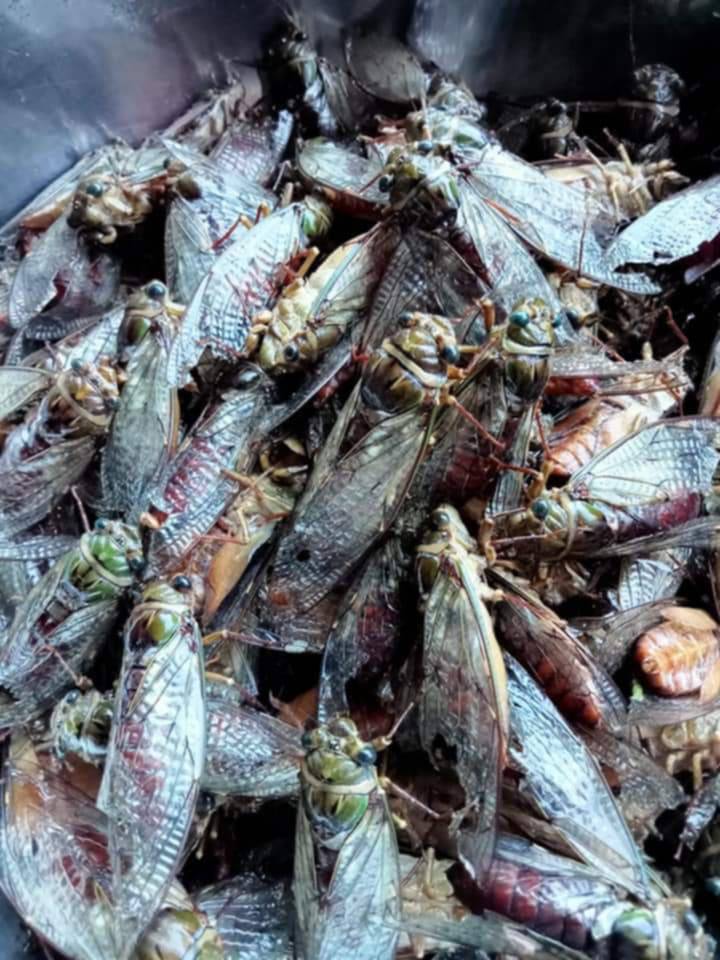“Ye kohlae ye koh kuakhee cho-a kohlue boo-a sayee bi be awa khleu mee kleu bla ka n alae khae-a jeu”
Ye (name in Pgakenyaw) or cicada; this verse is in the Pgakenyaw language which uses the voice of a cicada to compare it to the voice of a man who is not honest; and those who love each other well, but someone came and snatched the love one away.
In Ban Mae Yang Min (Mae Ya Mi khee), Sri Thoy subdistrict, Mae Sruay district, Chiang Rai province, there are Ye or cicadas that molt with the new white bodies once every seven years. The wings of new born cicadas are transparent and light blue, giving them a beautiful look. People preferably call them “fairies” or, in other words, Ye poh seu kha (small black cicada with white dots). This species, if translated according to the Pgakenyaw language, is called the ghost cicada because it comes out at night with a black color and its shrill voice that gives eerie feeling like the voice of a ghost. This species will come out eventually of the soil and gather together in bamboo groves or under the trees where they come out and molt. With their transparent and light blue wings, people call them fairies. Villagers love to catch cicadas when they are at the stage of fairies, because they are full of soft flesh. If left for a while, cicadas will begin to change their color to black. When they turn black, cicadas fly in groups to reside in bamboo groves of on big trees.
Cicada or Ye is a type of insect that sucks the sap of trees for consumption. It is said that the moment we hear its voice, cicada is in the last stage of its life. Because most of the cicadas’ life cycle is underground. It rises from the soil and molts as an adult, and begins to enter mating, then lays eggs and dies afterward. The time when we start to hear the cicada’s sound and find many of them is in summertime only around March to June. Villagers consider it another symbol of summer because when they start to hear the sound of cicadas, it indicates that they are already in summertime which coincides with the school vacation. Both children and adults of Ban Mae Yang Min (Mae Ya Mi khee), Sri Thoy subdistrict, Mae Sruay district, Chiang Rai province, normally wait to see whether there will be good number of cicadas for catch this year. Because in a year with abundant cicadas, people will have plenty of food and also for sale.

There are many varieties of cicada or Ye, both small and large. In Ban Mae Yang Min, there are three species of cicada: Ye, small greenish color like bark of a tree; Jua, large reddish-brown cicadas; and Ye poh ser kha, small black cicadas with white polka dots. The type of cicadas that is referred to as Ye can be found mainly along the stream and in residential area; in the afternoon, they produce the sound so loud and loudest in the evening. These cicadas prefer to stay on the trees and around the areas with water; specially, along the river bank, so many cicadas are found on the sand. Whenever we walk into the area, cicadas will fly all over the place and some of them even hit our face or cling to us. Along the river bank is a good place to catch cicadas for food because there are a lot of them there. The second species is called, Jua, large reddish-brown cicadas. They can be found only from dusk to very late at night on hot and humid night and mostly along the river that they come for a drink. The catchers are required to use their torch light to catch this type of cicadas. Elderly people in the village said that every four or seven years, there will be so many cicadas for catch. There was a year when a lot of cicadas were catched in a sack-full in one night and in that particular year too many cicadas lived on the longan trees and sucked the water from the tree trunks until many trees died.
Ye or cicadas normally gather in groups along the bamboo groves and when we approach this area our bodies will get wet from cicadas’ urine. Only every four or seven years, there will be abundance of cicadas that their voices overwhelm the whole forest. This makes some people feel disliked and annoyed. Actually, we will hear the sound of cicadas in only 2-3 months and that will also be the last part of cicada’s life cycle; they produce sound for mating, then laying eggs and die.
With the current decrease and deterioration of forest conditions, as well as the increasing number of people who are doing more and more chemical-based agriculture, together with the gathering of its larvae for household food and for sale, so the cicadas are decreasing rapidly. If we do not conserve natural resources, including the spawning areas of cicadas, we may never hear the sound of this insect again. The “fairies’ voice”, symbolizing the summertime that informs community members of the coming of summer may disappear forever.
Type: Blog
Region: Asia
Country: Thailand
Theme: Traditional and local knowledge and community-led conservation
Partner: IMPECT
Author: Maliwal Teja



